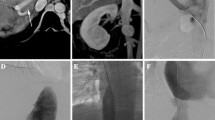Abstract
Objective
To evaluate the clinical efficacy and long-term outcomes associated with the treatment of hepatic vein (HV)-type Budd–Chiari syndrome (BCS) via accessory HV (AHV) recanalization.
Methods
In total, 26 HV-type BCS patients underwent AHV recanalization between July 2014 and December 2019 at our hospital, while 73 HV-type BCS patients without compensatory AHV underwent main HV (MHV) recanalization and served as controls in the present study. Short- and long-term clinical outcomes were compared.
Results
AHV and MHV recanalization approaches were both associated with 100% technical success rates, with one recanalization procedure being performed per patient. Respective clinical success rates for the AHV and MHV recanalization approaches were 96.2% and 94.5% (P = 0.744). Re-obstruction rates were comparable between these two approaches at 20% and 34.8%, respectively (P = 0.17). Primary cumulative 1-, 2-, and 5-year patency rates in the AHV group were 96.0%, 91.6%, and 76.3%, respectively, whereas in the MHV group, these three respective rates were 87.0%, 78.6%, and 58.6% (P = 0.048). Secondary cumulative 1-, 2-, and 5-year patency rates in the AHV group were 96.0%, 96.0%, and 96.0%, respectively, whereas in the MHV group, they were 97.1%, 97.1%, and 81.8%, respectively (P = 0.289). Cumulative 1-, 2-, and 5-year survival rates for AHV group patients were 96.0%, 96.0%, and 96.0%, respectively, while for the MHV group, these respective rates were 98.6%, 95.2%, and 89.7% (P = 0.462).
Conclusion
HV-type BCS can be safely and effectively treated via AHV recanalization, which may achieve longer patency relative to MHV recanalization.





Similar content being viewed by others
References
Zhang QQ, Xu H, Zu MH, et al (2014) Strategy and long-term outcomes of endovascular treatment for Budd-Chiari syndrome complicated by inferior vena caval thrombosis. Eur J Vasc Endovasc Surg 47:550-557.
Iliescu L, Toma L, Mercan-Stanciu A, et al (2019) Budd-Chiari syndrome - various etiologies and imagistic findings. A pictorial review. Med Ultrason. 21:344-348.
Gao X, Gui E, Lu Z, et al (2015) Risk factors of recurrence among 471 Chinese patients with Budd-Chiari syndrome. Clin Res Hepatol Gastroenterol 39:620-626.
Fu YF, Xu H, Wu Q, et al (2015) Combined thrombus aspiration and recanalization in treating Budd-Chiari syndrome with inferior vena cava thrombosis. Radiol Med 120:1094-1099.
Han G, Qi X, Zhang W, et al (2011) Percutaneous recanalization for Budd-Chiari syndrome: an 11-year retrospective study on patency and survival in 177 Chinese patients from a single center. Radiology 266: 657-667.
Fu YF, Li Y, Cui YF, et al (2015) Percutaneous recanalization for combined-type Budd-Chiari syndrome: strategy and long-term outcome. Abdom Imaging 40:3240-3247.
Cui YF, Fu YF, Wei N, et al (2015) Retrograde puncture assisted hepatic vein recanalization in treating Budd-Chiari syndrome with segmental obstruction of hepatic vein. Radiol Med 120:1184-1189
Tripathi D, Macnicholas R, Kothari C, et al (2014) Good clinical outcomes following transjugular intrahepatic portosystemic stent-shunts in Budd-Chiari syndrome. Aliment Pharmacol Ther 39: 864-872.
Fu YF, Wei N, Wu Q, et al (2015) Use of accessory hepatic vein intervention in the treatment of Budd-Chiari syndrome. Cardiovasc Intervent Radiol 38:1508-1514.
Li DM, Yin X, Yang F, et al (2020) Accessory hepatic vein recanalization for hepatic vein-type Budd-Chiari syndrome. Minim Invasive Ther Allied Technol https://doi.org/10.1080/13645706.2020.1723110.
Fu YF, Xu H, Zhang K, et al (2015) Accessory hepatic vein recanalization for treatment of Budd-Chiari syndrome due to long-segment obstruction of the hepatic vein: initial clinical experience. Diagn Interv Radiol 21:148-153.
Tang W, Zhang XM, Yang L, et al (2011) Hepatic caudate vein in Budd–Chiari syndrome: depiction by using magnetic resonance imaging. Eur J Radiol 77:143–148.
Yang F, Huang PC, Yan LL, et al (2019) Catheter Aspiration With Recanalization for Budd-Chiari Syndrome With Inferior Vena Cava Thrombosis. Surg Laparosc Endosc Percutan Tech 29:304-307.
Lu L, Xu K, Han C, et al (2017) Comparison of 3.0T MRI with 3D LAVA sequence and digital subtraction angiography for the assessment of accessory hepatic veins in Budd-Chiari syndrome. J Magn Reson Imaging 45:401-409.
Cai SF, Gai YH, Ma S, et al (2015) Ultrasonographic Visualization of Accessory Hepatic Veins and Their Lesions in Budd-Chiari Syndrome. Ultrasound Med Biol 41:2091-2098.
Chen ZK, Fan J, Cao C, et al (2018) Endovascular treatment for hepatic vein-type Budd-Chiari syndrome: effectiveness and long-term outcome. Radiol Med 123:799-807
Valla DC (2018) Budd-Chiari syndrome/hepatic venous outflow tract obstruction. Hepatol Int 12:168-180
Iliescu L, Toma L, Mercan-Stanciu A, et al (2019) Budd-Chiari syndrome - various etiologies and imagistic findings. A pictorial review. Med Ultrason 21:344-348
Funding
This work was supported by Clinical Medical Science and Technology Project of Jiangsu Province (Grant Number: BE2017637), Medical Innovation Team of Jiangsu Province (Grant Number: CXTDA2017028), and Key Research and Development Plan of Xuzhou City (Grant Number: KC20111).
Author information
Authors and Affiliations
Corresponding authors
Ethics declarations
Conflict of interest
The authors declare that they have no conflict of interest.
Additional information
Publisher's Note
Springer Nature remains neutral with regard to jurisdictional claims in published maps and institutional affiliations.
Rights and permissions
About this article
Cite this article
Lv, LL., Zhu, LL., Chen, GH. et al. Recanalization of accessory hepatic vein for hepatic vein-type Budd–Chiari syndrome. Abdom Radiol 46, 3456–3463 (2021). https://doi.org/10.1007/s00261-021-02977-1
Received:
Revised:
Accepted:
Published:
Issue Date:
DOI: https://doi.org/10.1007/s00261-021-02977-1




